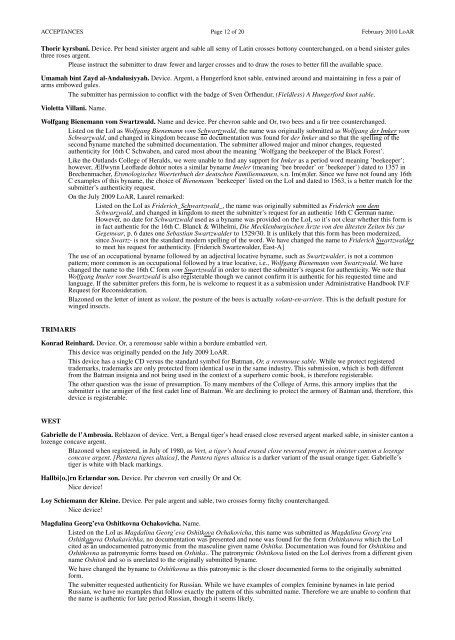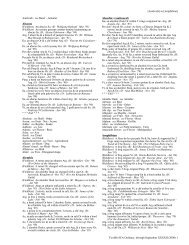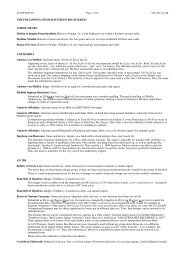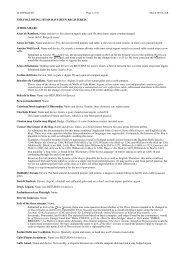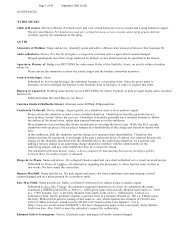Create successful ePaper yourself
Turn your PDF publications into a flip-book with our unique Google optimized e-Paper software.
ACCEPTANCES Page 12 of 20 February 2010 LoAR<br />
Thorir kyrsbani. Device. Per bend s<strong>in</strong>ister argent and sable all semy of Lat<strong>in</strong> crosses bottony counterchanged, on a bend s<strong>in</strong>ister gules<br />
three roses argent.<br />
Please <strong>in</strong>struct the submitter to draw fewer and larger crosses and to draw the roses to better fill the available space.<br />
Umamah b<strong>in</strong>t Zayd al-Andalusiyyah. Device. Argent, a Hungerford knot sable, entw<strong>in</strong>ed around and ma<strong>in</strong>ta<strong>in</strong><strong>in</strong>g <strong>in</strong> fess a pair of<br />
arms embowed gules.<br />
The submitter has permission to conflict with the badge of Sven Örfhendur, (Fieldless) A Hungerford knot sable.<br />
Violetta Villani. Name.<br />
Wolfgang Bienemann vom Swartzwald. Name and device. Per chevron sable and Or, two bees and a fir tree counterchanged.<br />
Listed on the LoI as Wolfgang Bienemann vom Schwartzwald, the name was orig<strong>in</strong>ally submitted as Wolfgang der Imker vom<br />
Schwarzwald, and changed <strong>in</strong> k<strong>in</strong>gdom because no documentation was found for der Imker and so that the spell<strong>in</strong>g of the<br />
second byname matched the submitted documentation. The submitter allowed major and m<strong>in</strong>or changes, requested<br />
authenticity for 16th C Schwaben, and cared most about the mean<strong>in</strong>g ’Wolfgang the beekeeper of the Black Forest’.<br />
Like the Outlands College of Heralds, we were unable to f<strong>in</strong>d any support for Imker as a period word mean<strong>in</strong>g ’beekeeper’;<br />
however, Ælfwynn Leoflæde dohtor notes a similar byname Imeler (mean<strong>in</strong>g ’bee breeder’ or ’beekeeper’) dated to 1357 <strong>in</strong><br />
Brechenmacher, Etymologisches Woerterbuch der deutschen Familiennamen, s.n. Im(m)ler. S<strong>in</strong>ce we have not found any 16th<br />
C examples of this byname, the choice of Bienemann ’beekeeper’ listed on the LoI and dated to 1563, is a better match for the<br />
submitter’s authenticity request.<br />
On the July 2009 LoAR, Laurel remarked:<br />
Listed on the LoI as Friderich_Schwartzwald_, the name was orig<strong>in</strong>ally submitted as Friderich von dem<br />
Schwarzwald, and changed <strong>in</strong> k<strong>in</strong>gdom to meet the submitter’s request for an authentic 16th C German name.<br />
However, no date for Schwartzwald used as a byname was provided on the LoI, so it’s not clear whether this form is<br />
<strong>in</strong> fact authentic for the 16th C. Blanck & Wilhelmi, Die Mecklenburgischen Ärzte von den ältesten Zeiten bis zur<br />
Gegenwar, p. 6 dates one Sebastian Swartzwalder to 1529/30. It is unlikely that this form has been modernized,<br />
s<strong>in</strong>ce Swartz- is not the standard modern spell<strong>in</strong>g of the word. We have changed the name to Friderich Swartzwalder<br />
to meet his request for authenticity. [Friderich Swartzwalder, East-A]<br />
The use of an occupational byname followed by an adjectival locative byname, such as Swartzwalder, is not a common<br />
pattern; more common is an occupational followed by a true locative, i.e., Wolfgang Bienemann vom Swartzwald. We have<br />
changed the name to the 16th C form vom Swartzwald <strong>in</strong> order to meet the submitter’s request for authenticity. We note that<br />
Wolfgang Imeler vom Swartzwald is also registerable though we cannot confirm it is authentic for his requested time and<br />
language. If the submitter prefers this form, he is welcome to request it as a submission under Adm<strong>in</strong>istrative Handbook IV.F<br />
Request for Reconsideration.<br />
Blazoned on the letter of <strong>in</strong>tent as volant, the posture of the bees is actually volant-en-arriere. This is the default posture for<br />
w<strong>in</strong>ged <strong>in</strong>sects.<br />
TRIMARIS<br />
Konrad Re<strong>in</strong>hard. Device. Or, a reremouse sable with<strong>in</strong> a bordure embattled vert.<br />
This device was orig<strong>in</strong>ally pended on the July 2009 LoAR.<br />
This device has a s<strong>in</strong>gle CD versus the standard symbol for Batman, Or, a reremouse sable. While we protect registered<br />
trademarks, trademarks are only protected from identical use <strong>in</strong> the same <strong>in</strong>dustry. This submission, which is both different<br />
from the Batman <strong>in</strong>signia and not be<strong>in</strong>g used <strong>in</strong> the context of a superhero comic book, is therefore registerable.<br />
The other question was the issue of presumption. To many members of the College of Arms, this armory implies that the<br />
submitter is the armiger of the first cadet l<strong>in</strong>e of Batman. We are decl<strong>in</strong><strong>in</strong>g to protect the armory of Batman and, therefore, this<br />
device is registerable.<br />
WEST<br />
Gabrielle de l’Ambrosia. Reblazon of device. Vert, a Bengal tiger’s head erased close reversed argent marked sable, <strong>in</strong> s<strong>in</strong>ister canton a<br />
lozenge concave argent.<br />
Blazoned when registered, <strong>in</strong> July of 1980, as Vert, a tiger’s head erased close reversed proper, <strong>in</strong> s<strong>in</strong>ister canton a lozenge<br />
concave argent. [Pantera tigres altaica], the Pantera tigres altaica is a darker variant of the usual orange tiger. Gabrielle’s<br />
tiger is white with black mark<strong>in</strong>gs.<br />
Hallbi{o,}rn Erlændar son. Device. Per chevron vert crusilly Or and Or.<br />
Nice device!<br />
Loy Schiemann der Kle<strong>in</strong>e. Device. Per pale argent and sable, two crosses formy fitchy counterchanged.<br />
Nice device!<br />
Magdal<strong>in</strong>a Georg’eva Oshitkovna Ochakovicha. Name.<br />
Listed on the LoI as Magdal<strong>in</strong>a Georg’eva Oshitkova Ochakovicha, this name was submitted as Magdal<strong>in</strong>a Georg’eva<br />
Oshitkanova Oshakavichka, no documentation was presented and none was found for the form Oshitkanova which the LoI<br />
cited as an undocumented patronymic from the mascul<strong>in</strong>e given name Oshitka. Documentation was found for Oshitk<strong>in</strong>a and<br />
Oshitkovna as patronymic forms based on Oshitka.. The patronymic Oshitkova listed on the LoI derives from a different given<br />
name Oshitok and so is unrelated to the orig<strong>in</strong>ally submitted byname.<br />
We have changed the byname to Oshitkovna as this patronymic is the closer documented forms to the orig<strong>in</strong>ally submitted<br />
form.<br />
The submitter requested authenticity for Russian. While we have examples of complex fem<strong>in</strong><strong>in</strong>e bynames <strong>in</strong> late period<br />
Russian, we have no examples that follow exactly the pattern of this submitted name. Therefore we are unable to confirm that<br />
the name is authentic for late period Russian, though it seems likely.


